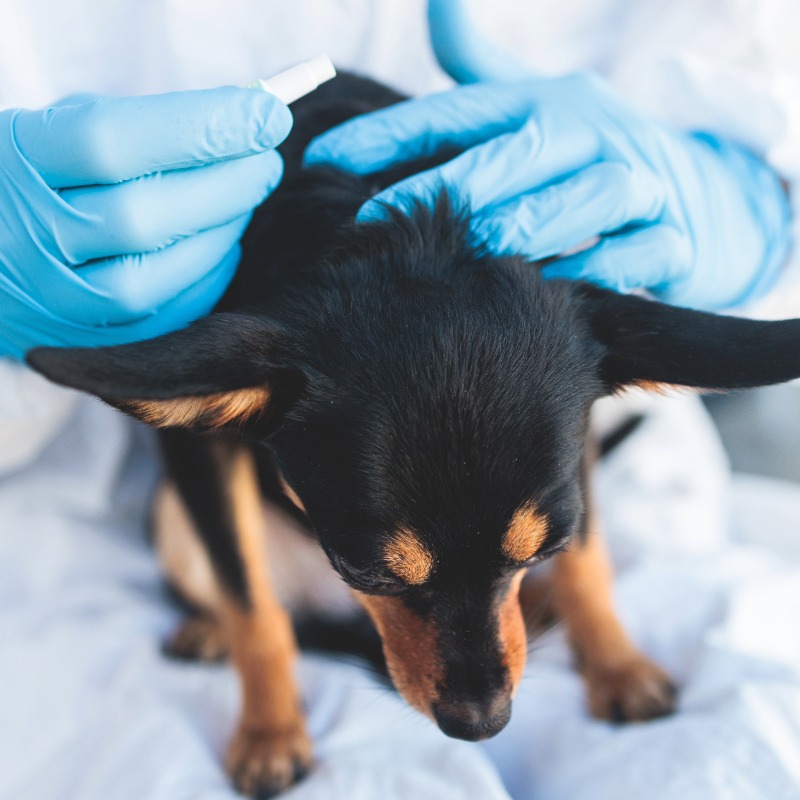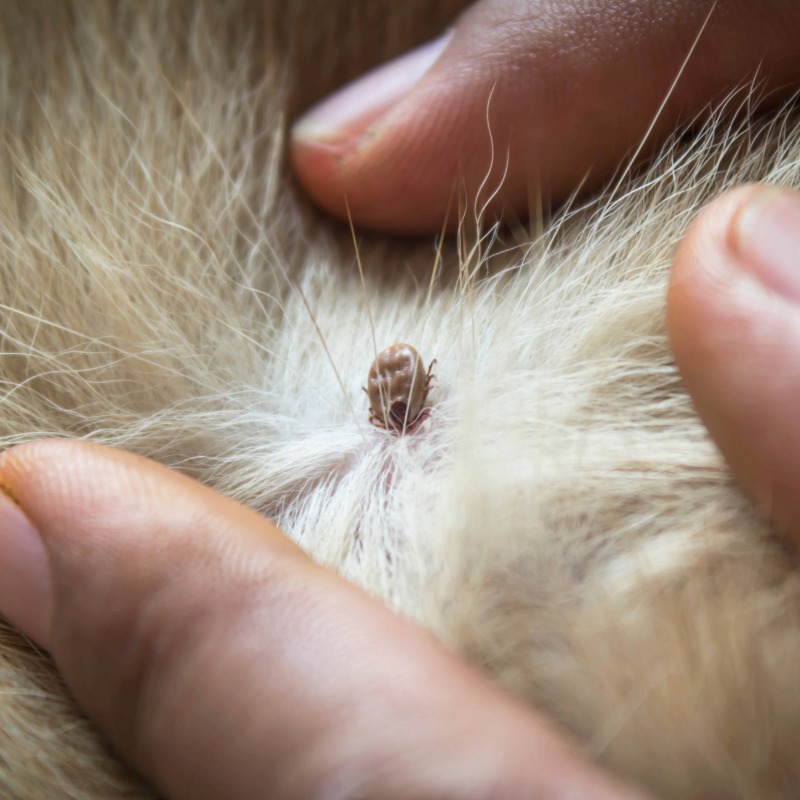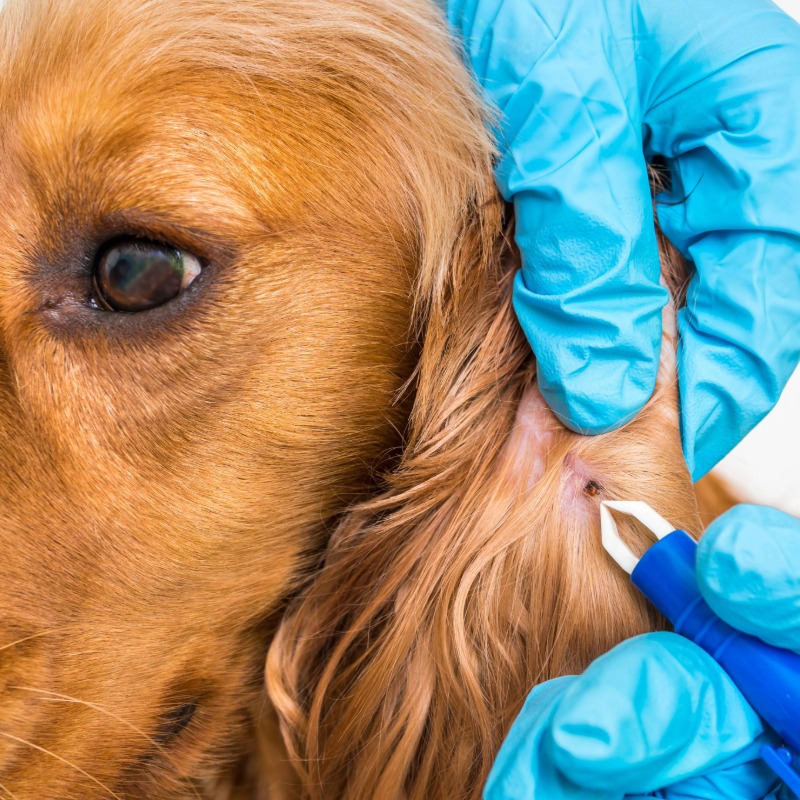Parasite Control:
Paralysis Ticks, Fleas & Worms

Paralysis Ticks
Let’s start with the big one – Paralysis Ticks are a problem throughout Sydney, but the dogs of St Ives and our surrounding suburbs are particularly prone to paralysis ticks and their devastating effects due to our proximity to the bush and therefore our large populations of possums, lizards and bandicoots who are the natural hosts.
Ticks are small external parasites that attach to and suck the blood of animals (and humans). There are many species of ticks within Australia, however the most common species and the one we are most worried about with our pets is the paralysis tick.
The paralysis tick produces a toxin in its saliva which is passed on to the host animal when the tick feeds. This can lead to the development of tick poisoning in your animal. Ticks most commonly attach to dogs and cats by climbing onto grass and bushes where they wait for passing hosts to attach to, however there have been cases where ticks have been brought into the home on the clothing of owners, so we recommend that even our indoor-only pets have prevention on board.
It’s well-known in our area that ticks thrive in the spring and summer months (often referred to as tick season), however in recent years we have seen a steep increases in tick paralysis cases in the colder months. It is no longer an option to just treat your pet with tick prevention during the spring and summer, they really need protection all year round – luckily there are now some longer-acting prevention options available!
We outline all the tick prevention options that our vets recommend in our Vaccination and Parasite Control Charts, but all tick prevention manufacturers still recommend owners perform daily tick searches on their pet.
How to check your dog for Ticks?
Most ticks are found around the head, neck and shoulders/front legs, however they can potentially attach anywhere on your dog, so it is important to also check areas such as the chest, back, abdomen, legs, tail, under the armpits and in between toes.
To check your dog for ticks, use your fingertips to feel through your animal’s coat. Ticks or tick craters (raised or sunken areas where a tick may have attached) feel like small lumps on the skin surface.
I’ve found a Tick – Help!
If a tick is found, it should be removed as soon as possible.
We recommend a special hook known as a Tick Twister which can slide under the tick, then use a twisting motion to remove the tick before pulling it off.
Tweezers will do if you don’t have a Tick Twister handy, just ensure you use the same twisting motion to remove the tick whole. Your vet or nurse can show you how!
I’ve removed the Tick – Now what?
When one tick is found, chances are there could be others hiding in your dog’s fur or attached to their skin. It is important to perform a thorough tick search all over to identify and remove any other ticks you may find.
You will need to watch your dog closely for any of the following signs of tick paralysis and bring them straight into us if you notice any of these symptoms:
- Lethargy
- Weakness or loss of coordination in the hind legs (wobbliness or not being able to get up)
- Change in the sound of their bark or meow
- Retching, coughing or vomiting
- Loss of appetite
- Progressive paralysis to include the forelegs
- Laboured or rapid breathing
Tick poisoning is a serious and potentially life-threatening condition, and the amount of treatment can vary depending on the individual case. Many dogs will deteriorate for a day or more despite having the tick removed and treatment implemented.
Your dog will be admitted into hospital and given a pre-medication to help calm them and reduce salivary excretions. These medications will also minimise the risk of an adverse reaction to the tick anti-serum. Once these medications have had time to take effect an intravenous catheter is inserted into the foreleg and the tick antiserum is slowly injected. The tick antiserum aims to neutralise the tick toxin.
Unfortunately, there is always a potential risk of an adverse reaction to the antiserum. This is more common in cats than dogs, and more common in animals that have been treated multiple times. Such an adverse reaction can vary from a sudden drop in blood pressure which we can treat and correct through to rarely acute anaphylactic reaction resulting in death.
Whilst your dog is receiving the anti-serum their vital signs are monitored regularly. All cases are unique and different components of the disease can affect one case more than another (even in the same dog on subsequent episodes of tick poisoning). For example, some animals may have more difficulty breathing but be able to walk, whilst others may be unable to walk at all, but their breathing is only mildly affected.
For this reason, treatment protocols vary, with some animals requiring intravenous fluids to maintain hydration and others requiring oxygen support to assist breathing. Many animals affected by tick poisoning also lose the ability to urinate and so need their bladders expressed manually or are unable to blink and so need their eyes lubricated regularly.
Fleas
Fleas can be distressing for your pet, but they are more than just a nuisance!
Fleas can cause skin disease, anaemia and transmit infectious or parasitic diseases, some of which can be transmitted to humans too.
In some animals, fleas can also trigger an allergic condition called flea allergy dermatitis; a skin disease that is intensely itchy and can result in hair loss and skin infections. For pets with this condition, even a single flea can cause intense irritation, meaning year-round flea control is essential!
Spotting fleas isn’t always easy – they are small and fast, and some pets can show signs of severe itchiness and irritation when only a few fleas are present.
The other thing to consider is that the adult fleas you see on your dog are only part of the problem. You may be surprised to learn that adult fleas (the ones you can see) make up only about 5% of the total population. The remaining 95% (eggs, larvae and pupae) are found in carpets and bedding – in fact anywhere in your house! Each female flea can lay up to 50 eggs per day, so it doesn’t take long for an infestation to take hold.
For this reason, if you find live fleas on your pet and you treat them, you must also treat the environment as well! There are many “flea-bomb” options available, but please read the label carefully and follow instructions to keep pets and kids safe.
Intestinal Worms
Both cats and dogs can be infected with various intestinal worms including roundworm, whipworm, hookworm, and tapeworm.
Not only can these make your dog sick, but they can also infect people, so it’s important to regularly treat your pets for worms and wash your hands after touching any other dogs or cats.
Kittens and puppies have a more regularly intestinal worming schedule than older pets (see our Puppy Care Guide), but we recommend dogs and cats over 6 months old are treated for intestinal worms every 1-3 months, depending on the product you are using. You can refer to our Vaccination and Parasite Control Charts to help you decide which option is right for your dog.
Heartworm in Dogs
Heartworm is a parasite seen mostly in dogs and is spread by mosquitoes, causing death in dogs if left untreated.
Heartworm is difficult to treat but easy to prevent.
If your dog has not had heartworm prevention before, your vet may recommend running a heartworm test before starting, since giving a dog heartworm prevention if they already have heartworm infection will not kill the heartworm already present.
You can refer to our Vaccination and Parasite Control Charts to help you decide which option is right for your dog.







